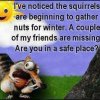Wrong its not all about the rut and I would think you know better. I've seen deer dart out of fields with combines running. I've seen deer be pushed out of an area by hunters loudly approaching their stand in the morning. Ive seen deer start running from missed shots. I could go on but you of all people know that added pressure and hunters etc can and does change patterns. When daytime pressure increases nocturnal movement increases, it the rut plus what he said and probably more.
Sent from my Fisher Price - ABC 123
Deer are primarily nocturnal to begin with. Deer, when pushed by a combine will, if there are other rows left, normally run about 20-30 yards and circle right back into the corn. Deer will start to run after a missed shot, then most times, again, circle back.
Deer are habit driven. They seldom leave a rather small area. They will move if food sources are lost. In the spring yearling bucks move, sometimes miles, to establish their "ground". This movement helps to maintain genetic diversity. During the rut a buck will extend the normal range he moves in. They go NUTS. Kinda like a teen age boy when puberty hits.
I have a 10 point on my wall at home. Not huge, but the biggest I have ever taken. When we meet someday remind me to tell you the story of that deer. It just stood there, and let me shoot it, it KNEW I was there. Why? He had his nose up a does butt.
If you removed ALL of the above things mentioned, the deer would STILL run like idiots across roads during the rut. You can drive through National parks, at night, NO farming, NO hunting, and find the exact same thing happening.
Roads where put in where deer live. THAT is the primary cause of the problem. Deer do what deer do. They have set patterns at different times of the year. Rutting patterns are wild but, assuming one has the time to scout and one knows what one is doing, just as predictable as all other deer patterns are.
Hunting pressure, crop removal, may play a role, but it is a small role. The rut, along with roads put where deer run are the primary causes.
A more accurate definition of when deer move:
"White-tailed deer are neither nocturnal (meaning they move about at night) nor diurnal (meaning they move about during the day); instead, they are considered crepescular, which means they are most active near sunrise and sunset."





